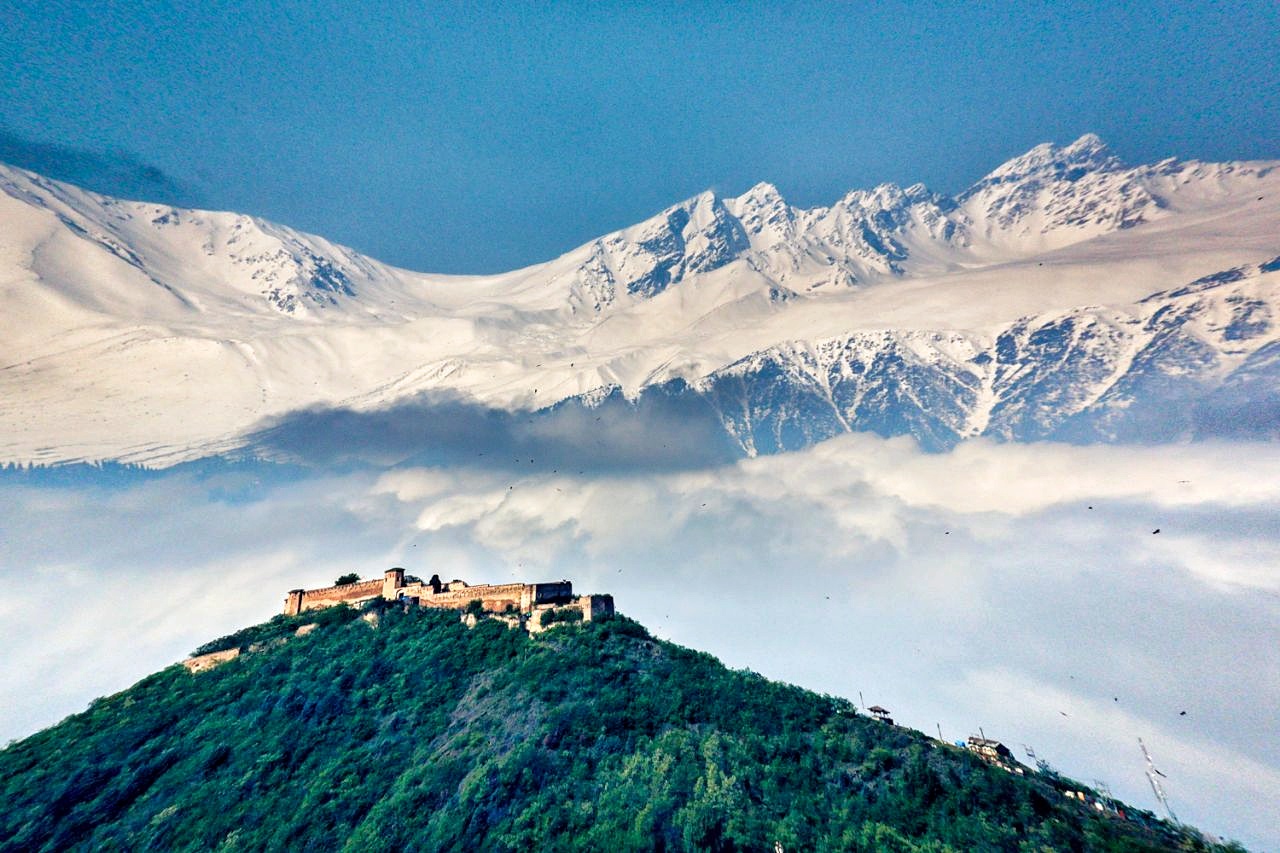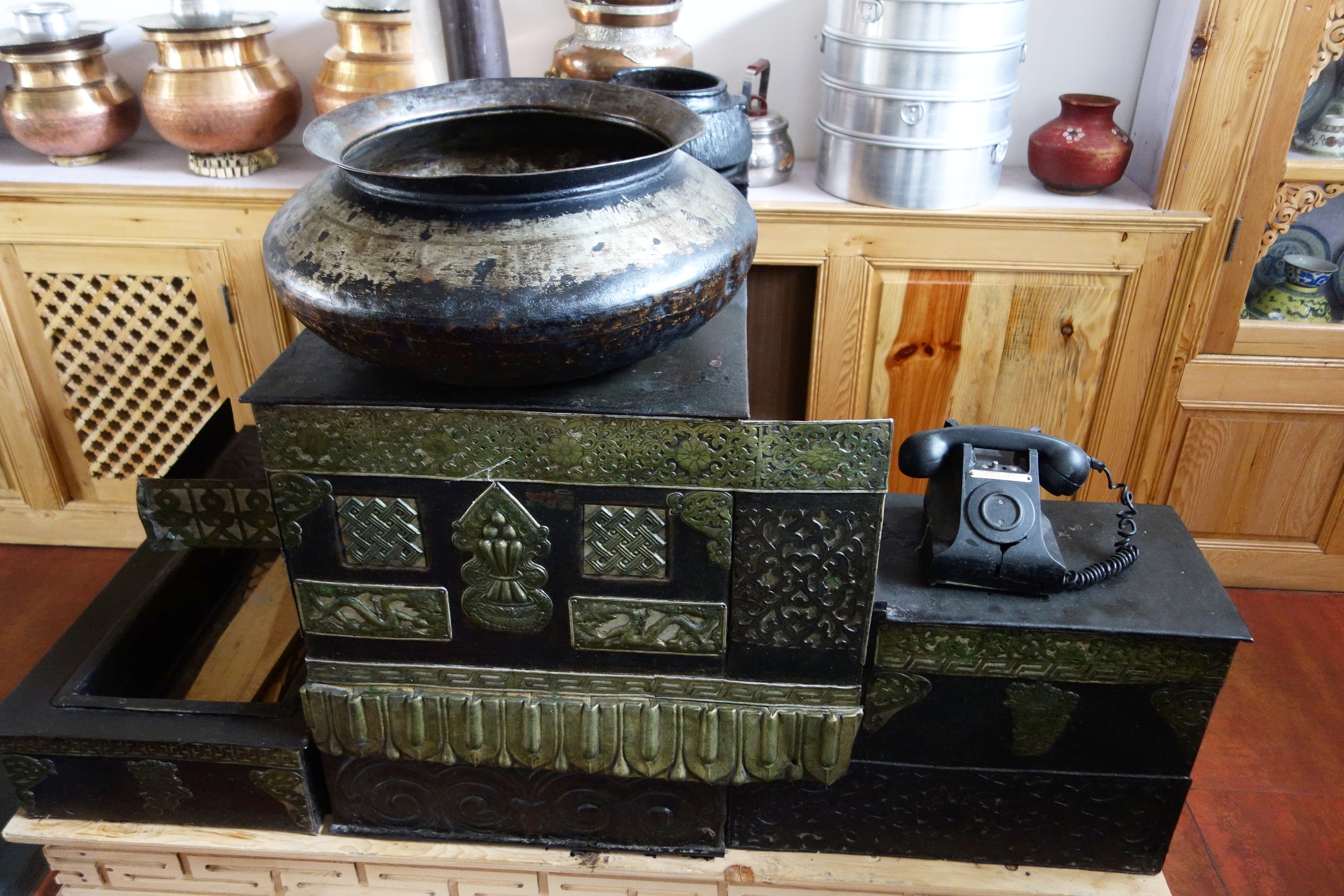The Trans-Himalayan Silk Route Tour
Our special Curated Tour to take you in the footsteps of the Century’s old Silk Route over the Himalayas which connected the Northern Plains of India with Central Asia, Tibet and China. This Route which went over the most formidable chain of Mountains in the World was an epic Journey which took months and was fraught with danger. Though the Trade came to halt in 1949 due to the closing of borders and territorial disputes there are still enough reminders and landmarks continue to exist today. Through our Research over the Years we have now established a Trail by which we give you a taste and a history of this most historic and daunting of Trade Routes. The Worst Trade Route in the World as someone aptly put it.
The Itinerary
The Hari Parbat Fort in Srinagar with the Pir Panjals in the background.
Day 1 : Srinagar : We pick up the Trail from Srinagar in the most beautiful of the Himalayan Valleys. Srinagar was the point from which there ran a Route up the Mountains into Ladakh. The Maharaja of Kashmir and the British signed an agreement and established the Treaty Road as a part of the Yarkand Mission which was supposed to run from Srinagar to Yarkand in Central Asia in the Tarim Basin.
We stay at a luxury Resort owned by a family which belonged to the Ruling Class in Afghanistan but had migrated to Kashmir in the early 1900s and had taken up service with the Maharaja of Jammu and Kashmir. The Resort itself is situated on the Route which leads from Srinagar towards Ladakh.
Day 2 : Srinagar : We visit the Yarkand Sarai in Srinagar, which as the name suggests was the place where traders from Yarkand and Central Asia used to put up when they came to Srinagar for trading purposes. There are still people of Central Asian Uyghur people who settled in Srinagar and have now lived here for generations.
The Yarkand Sarai present day (Pic courtesy Al Jazeera)
After the Yarkand Sarai, we visit the Central Asian Museum in the Kashmir University. It contains a good collection of items related to Central Asia as well as the Silk Route. Afterwards we visit the Sri Partap Singh Museum in Srinagar and go through the excellent Collection of Kashmiri History and Craft which is at display at the Museum.
Day 3 : We depart for Kargil and cross the formidable Zoji La (Pass) which was the gateway through the Great Himalayan Range into the Trans Himalayas and the world beyond. Zoji La still remains one of the most thrilling Passes in the Himalayas and driving over it is an experience in itself. After going over the Pass we arrive at Kargil where we put up at a Hotel with a Bomb Shelter. Kargil was the scene of a high altitude war between Indian and Pakistan in 1999 and the Bomb Shelter is a relic of that time as peace has now returned.
The Zoji La (Pass) as it cuts through the Great Himalayan Range
Kargil used to be one of the main Towns in the crossroads of the Trade Routes as it stood equidistant from Srinagar, Leh, Skardu and Zanskar. Kargil still has an appearance of an old trading Town with a mix of cultures. We have a private visit to the Munshi Aziz Bhat Museum in the afternoon and run through the treasure of Trade goods from the olden times that they have in their Collection. Munshi Aziz Bhatt was a petition writer for the Maharaja of Jammu and Kashmir in Kargil and was also involved in the Central Asian Trade. He had built a Sarai for the Traders which still exists today, though in a derelict condition. Many of the Exhibits at the Museum were unearthed during excavation at the Sarai a couple of years back.
Horse Saddles from various Central Asian Countries at display at the Munshi Aziz Bhatt Museum, Kargil
Day 4 : We visit the Village of Hundarman which stood on a ridge overlooking the Shingo River and the Route that connected Kargil with Skardu. Till 1971 this Village was under the control of Pakistan but then was taken by India. It faced the brunt of the War in 1999 and the landmines on the sides of the Road to Hundarman are still a reminder of the Past. You would see many signboards warning about Landmines on your way to Hundarman.
The Hundarman Village
In the old Hundarman Village we visit the Community run Museum which has an interesting collection of items from the Past.
Later we drive through the Suru Valley and go to Panikhar to have a glimpse at close quarters of the Himalayan twin giants Nun and Kun which stand at over 7000m and are the highest Peaks of the Himalayas in the Indian controlled part of J&K. We also indulge in a round of Archery which is a favorite sport in the area.
The Highest Himalayan Peak in Ind,an controlled Territory in Jammu and Kashmir, Mt.Nun at 7135 m (23409 ft) amsl.
Day 5 : We leave towards Leh and on the way we visit the remains of the of the Chiktan Khar Fort which served as the protection for the Trade Route along the Indus going North. After Chiktan we visit the Citadel of Basgo and the Monastery. This was the scene of the Battle of Basgo fought between the Mughals and the Mongols a couple of hundred years ago. We proceed to Leh.
The Chiktan Khar (Fort)
The Citadel of Basgo which used to be the Capital of Ladakh once upon a time.
In Leh we stay at Hotel owned by a Gentleman which is built on the spot where there was a Sarai for the Traders. The Sarai has now been replaced with a Hotel but the Hotel still has an impressive Collection of artifacts connected to the Trade and Central Asia. Which isnt surprising as the Gentleman’s own Mother came from Kashgar and is of Central Asian descent.
An Antique Traditional Stove at display at a Hotel which was built on the exact location where a Trader Sarai existed decades ago.
Day 6 : We take it easy as we need to acclimatize at Leh is almost at 3500 m above seal level. We visit the Central Asian Museum in Leh and roam around the Bazaar. We even visit stores in the Bazaar run by Punjabi Traders who’s ancestors were a part of the Central Asian Trade or Yarkand Trade as it is commonly known.
The Karakorams as seen from the Khardung La (Pass)
Day 7 : We drive over the 5329 m high Khardung La (Pass) one of the highest Motorable Passes in the world and enter the Nubra Valley. This Pass was the first one in a series of Passes on the way to Central Asia and Yarkand. We enter the Nubra Valley which was the gateway to the Karakoram Mountains. One of the vestiges of the trade are the Bactrian Camels which came to Nubra over the Passes from Central Asia and stayed. We see these majestic animals at work as they now give joy rides to Tourists in Nubra. Overnight we halt at Nubra as beyond the Valley the Road goes to the Siachen Glacier, a military outpost which is often described as the highest Battlefield in the world.
Day 8 : Return to Leh over the Khardung La (Pass) and the day at leisure. And the Tour ends with a questions and answer session and a Dinner Party.
Day 9: We take a flight back to New Delhi from Leh.
Features :
Our Itineraries are specially crafted to give you an Experiential Experience even at the regular Tourist Hotspots.
Our Stays are at Boutique Cottages and not at Hotels/ Resorts. Its gives a Personal and a Homely touch to your Kashmir visit.
Our Meals are crafted to give you a flavor of the famous Kashmiri Cuisine both Veg and Non Veg.
All our Transfers are by Innovas and we put just 4 Guests in an Innova.
Terms and Conditions :
Inclusions : Stay with Breakfast and Dinner / Sightseeing / Local Transfers / Airport Pick Up and Drop
Exclusions : Lunch / Shikara Ride / Gondola Ride / All Expenses of a Personal Nature
Cost : Rs.35000/- per person on Twin Sharing Basis. GST 5% Extra. Gurez Per Person would be 15000/- per Person.











